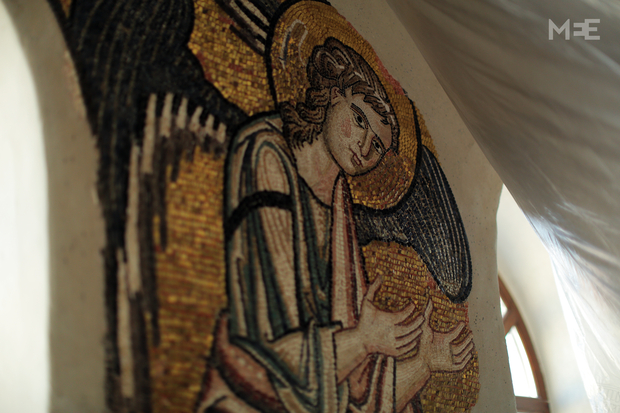A long-hidden angel mosaic made from rocks, shells and gold was uncovered during renovations at the Nativity Church. BETHLEHEM, Occupied Territories – For at least several centuries, the walls of the Nativity Church, where Jesus Christ is said to have been born, have hidden a secret angel behind layers of plaster.
The angel, made from tiny squares of brightly coloured rocks, shells, glass and gold was uncovered during renovations at the church, and now lies behind a tarp of plastic as construction on the holy site continues. Renovations are slow and meticulous due to the historical and religious importance of the delicate artefacts, and the angel is not expected to be put on display to the public until at least the summer.
Afif Tweme, project manager for the renovations, said the historic piece of art was found when renovators used laser technology to scan the church before new construction started.
“We needed to make sure we were not ruining anything, or missing anything like this angel, before we started the renovations,” Tweme explained.
Local and Italian renovation teams suspected something might be behind the surface of the wall that was slightly raised due to a layer of plaster, but they had no idea what they would find.
“There was no record of this angel ever being here, or of people covering up an artefact on this wall,” Tweme said, standing on scaffolding that allowed the manager to stand directly in front of the newly found mosaic near the high ceiling of the church.
Tweme said renovators believe the angel has been covered for hundreds of years.
“We think that at the time, the people in charge of the church realised that the angel was becoming damaged, losing pieces here and there from its face and around the edges of the work, so they covered it up to prevent any further damage,” he said, explaining that those who covered the angel up would not have had the tools needed to properly preserve the piece.
Dr Michele Bacci, an art-historical consultant and member of the scientific team in charge of the restoration of the Nativity Church, said that since the 19th century there has been a big discussion among scholars as to the exact date of the mosaics.
Bacci explained that some scholars thought that the work “might date back to the 8th century on account of their aniconic character, which shows some connections with the mosaics of the Dome of the Rock in Jerusalem.”
The restoration project, however, gave scholars and researchers better insight into the actual age of the artwork.
Read the complete article on middleeasteye.net


